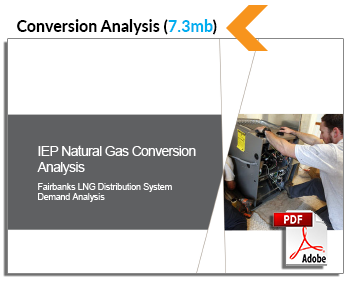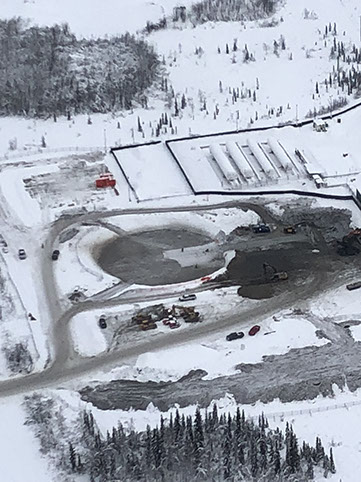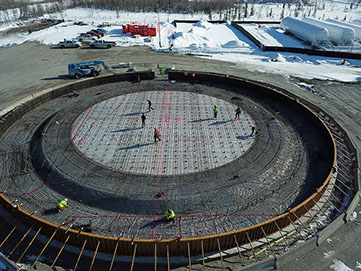Project Overview
Interior Energy Project Overview
High transportation costs, challenging environmental conditions, logistical problems and punishingly cold winters all contribute to high energy costs in Interior Alaska.
The IEP provides the financial tools needed to bring natural gas to Interior Alaskans. Legislation passed in 2013 authorizes AIDEA to provide the financing package to partner with the private sector to bring affordable, clean-burning natural gas to Interior Alaska. AIDEA has been working diligently on the IEP goal of getting natural gas to as many Interior Alaska customers as possible, at the lowest cost possible, as soon as possible.
Clean-burning natural gas will help substantially improve Fairbanks and North Pole air quality by providing an affordable substitute to wood and oil-burning heating systems. This will help the region once again meet federal Environmental Protection Agency (EPA) standards. A new source of affordable natural gas will also provide the community relief to high-energy costs.

AIDEA is working to advance the IEP through the following actions:
- Full supply chain integration. AIDEA continues to work with the Interior Utilities Fairbanks Natural Gas (FNG) and the Interior Gas Utility (IGU) to plan the build out and coordination of transportation, storage, regasification and distribution of natural gas in the Interior.
- Financing liquefaction capacity. AIDEA intends to work with a private partner to develop LNG capacity for the Interior market. Legislation approved in February 2015 extended AIDEA’s authority to finance LNG capacity anywhere in the state.
- LNG Transport. In order to help lower the cost of transportation, AIDEA is working diligently on evaluating railroad and road alternatives. The logistics and cost of transporting LNG are the driving considerations in AIDEA’s due diligence process.
- Finance natural gas distribution system planning, design and construction. As of March 2015, AIDEA has authorized $37.8 million for development of the IGU distribution system and another $15 million for expansion of the FNG distribution system. These projects add up to an additional (approximately) 140 miles of installed natural gas distribution pipe within the Fairbanks North Star Borough (FNSB) by fall 2015.
Natural Gas Distribution System
A critical element for a successful LNG delivery project is the build-out of a natural gas distribution system, connecting customers to this new and expanded energy source. Once the LNG is transported to Interior Alaska, it will be stored and then warmed back to a gaseous state prior to being distributed to customers by a network of pipes. The storage tanks will also help to meet peak demand during winter months. The AIDEA and IGU Boards agreed to initiate construction of a 5.25 million gallon storage tank in December 2017. Construction began in January 2018 and has progressed rapidly. The foundation site was excavated, backfilled, and a thermo-syphon system was installed to maintain an appropriate ground temperature below the facility. A single, continuous concrete pour was completed to create the foundation for the expanded LNG storage site. The LNG storage project has a target completion date of fall 2019.
In order to move the gas to homes and businesses, natural gas distribution lines, or “mains” have been installed in the medium and high-density areas of the FNSB. Natural gas runs from the main to a home or business through a small-diameter pipe called a service line. Although the distribution company is anticipated to cover a portion of the cost of each customer hook up, there will be a modest fee to extend the service line to individual properties. The cost of converting the existing heating system and other appliances to natural gas will be the responsibility of the individual property owner. The payback period is largely dependent on factors like a home’s existing heating use, potential savings and the necessary conversions of home appliances to gas. Click here for conversion analysis information.
The gas distribution system is critical for building demand and reducing the cost customers pay for natural gas. As the number of customers purchasing natural gas increases, the fixed operating cost will be spread more broadly and the unit price will be reduced. Although details of the costs and commercial structure are still being refined, the estimated delivered price of trucked LNG to the Interior will result in savings to ratepayers. The full distribution build-out for the high and medium density areas of the FNSB may take years to complete.
The IEP is not only compatible with a natural gas pipeline, but complements a pipeline by creating greater initial demand. Trucking LNG provides an affordable energy option for the FNSB and incentivizes residents and businesses to convert to natural gas, supporting the construction of a distribution system before the anticipated natural gas pipeline arrives.




